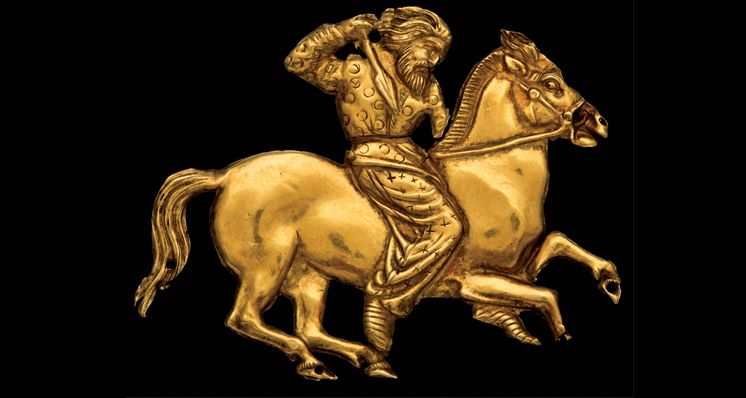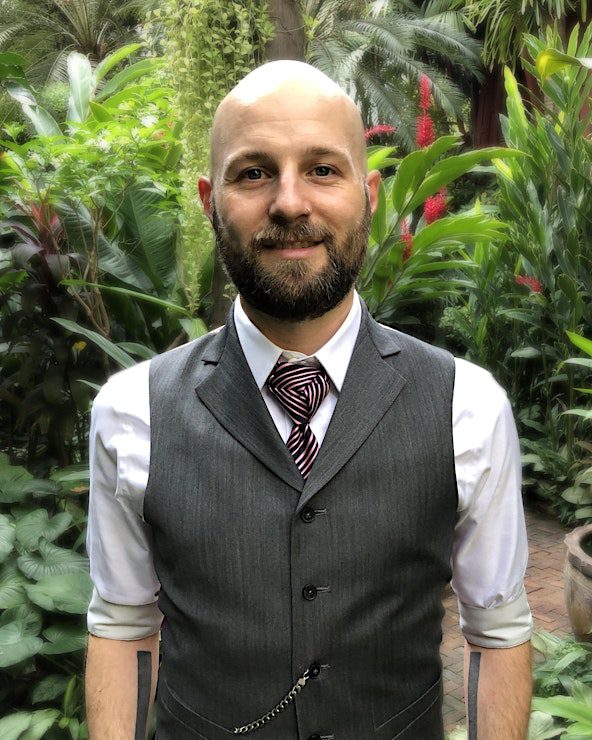On Tuesday 27th March 2018, Gem-A’s new editorial coordinator, Dr Sarah Bremner, joined a gathering of the Society of Jewellery Historians at the Society of Antiquaries, Burlington House, Central London for their March lecture: ‘Gold of the Scythians: art, culture and techniques’ by the British Museums’ St John Simpson and Aude Mongiatti. Here, she summarises their fascinating lecture.
Those fortunate enough to have had the opportunity to see the BP exhibition ‘Scythians: warriors of ancient Siberia’, which was on display at the British Museum from 14 September 2017 – 14 January 2018, will have witnessed the exquisite gold craftsmanship of this nomadic culture – but for those who didn’t have the chance this talk was a great opportunity to learn about these ancient nomadic warriors and the spectacular – and probably unexpected – quality of their gold-work.
The Scythians have often been treated as an ‘other’ in ancient sources, such as by Herodotus in his Histories. But unlike our modern concept of history, the Greek word historia (ἱστορία) actually means inquiry – to discover, to learn, to know – and Herodotus’ work is part of a wider movement in Ancient Greek thought that began to ask questions about the world. The Scythians – the subjects of this fascinating lecture – for Herodotus at least, were renowned and different enough to warrant a chapter in their own right in his epic exploration of culture, religion, politics and ethnography. But this was still Scythia from an outsider’s perspective. Since they left no written records themselves, to truly discover the Scythians we must look at their crafts, as it is only through their glittering archaeological record that we can hear their voice and attempt to understand Scythian culture.
READ MORE: Jurassic Jet: A Look to the Past to Preserve the Future
Showcasing select items from the British Museum’s exhibition, and some previously unseen objects of the Oxus Treasure, St John Simpson, senior curator responsible for the pre-Islamic collections from Iran and Arabia at the British Museum, opened the lecture with the inspiration behind this exhibition, before providing some historical and cultural context for the fascinating objects that help us to glimpse this nomadic society.
Offering a great opportunity to introduce the unfamiliar – something the Scythians have been since antiquity – Dr Simpson noted that the British Museum has always sought to tread a new path from other organisations, and when discussing ways to commemorate the 100th anniversary of the Russian Revolution, the British Museum sought to tell a Russian story with Russian Objects, but in a completely new way.
But what story? After reaching out to the State Hermitage Museum of St Petersburg Russia, the British Museum was given access to Peter the Great’s Siberian Collection which was part of the first Russian museum, the Kunstkamera. From this collaboration the Scythian exhibition was designed to showcase the oldest flourishing society of the area that would become Russia, to challenge modern and ancient preconceptions of nomads as uncivilised and, instead, showcase the remarkable skills and craftsmanship of Scythian society. Created for this specific purpose, the exhibition was unique and one of a kind.
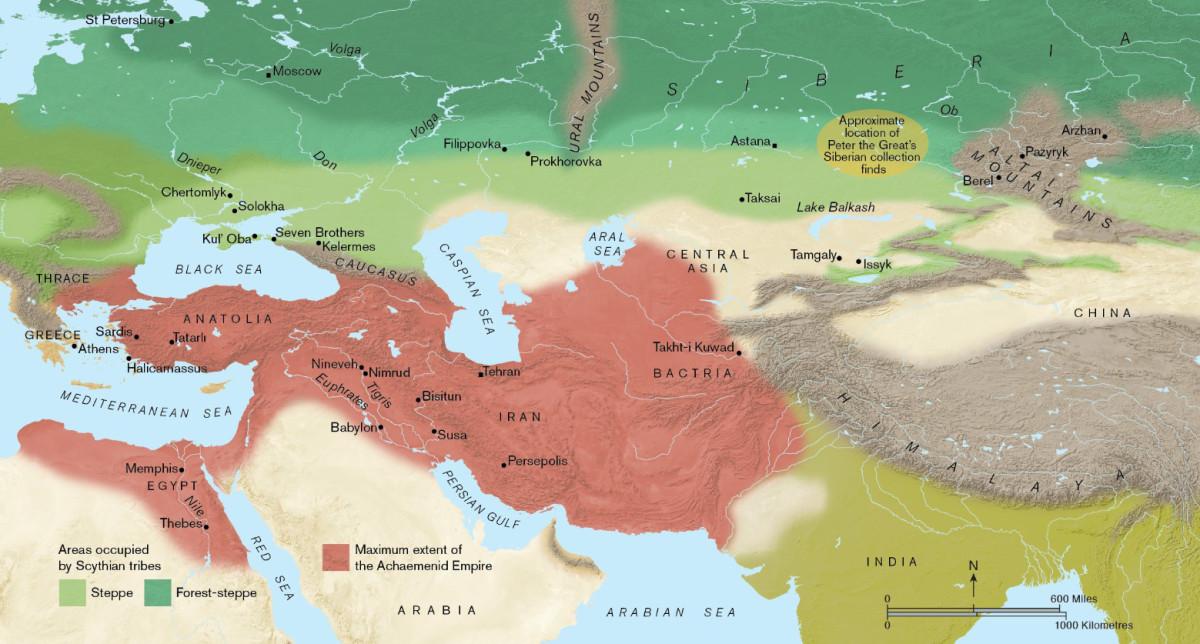

Map showing scale of Scythian Territory. Achaemenid Persia in red, Scythians in Light Green. Map produced by Paul Goodhead.
Read more: Myths and Legends: discover the ancient link between amber and the sea
With a brilliant blend of context and specialist knowledge for his audience, Dr Simpson showed us a map of the Scythian World from the 6th-4th centuries BCE, highlighting the expanse of Scythia stretching from the Altai mountains near China, divided from Achaemenid Persia by mountain ranges and the Caspian Sea, along the Black Sea region to Thrace and the edge of the Greek world. By acknowledging the scope of Scythian territory, we can then appreciate the interactions of Scythian culture with the varied ancient civilisations of the period.
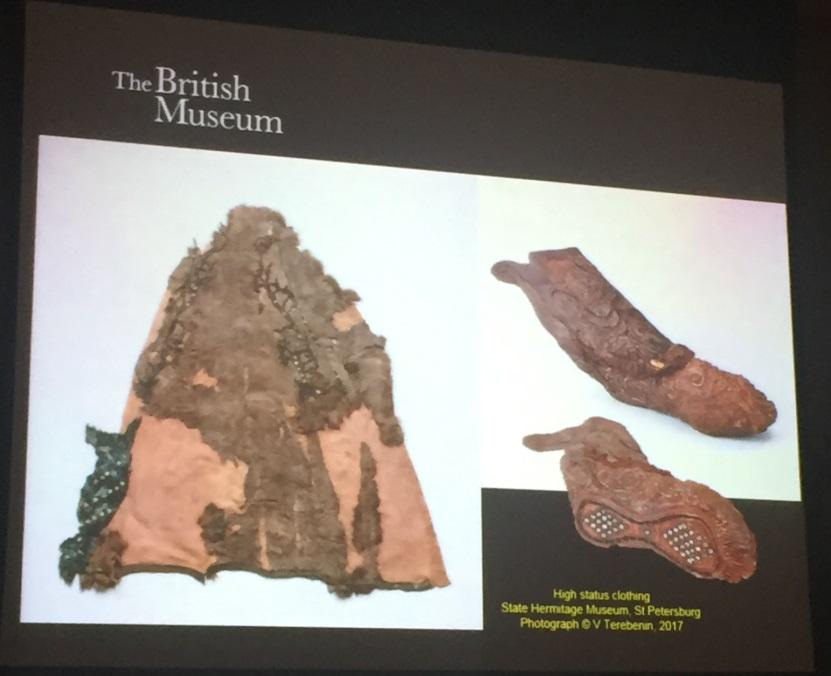

Woman’s shoe. Leather, textile, tin, pyrite crystals, gold foil, glass beads. Burial mound 2, Pazyryk, Altai mountains, southern Siberia, late 4th–early 3rd century BC. Photo © V. Terebenin 2017.
Building on this mix of geography and culture, Dr Simpson explained the importance of understanding the significance of Scythian burial practices; buried in valleys in the summer, Scythian tombs demonstrate a culture that was invested in the afterlife with a sense of permanence, as these underground tombs would freeze over in Winter. This was crucial, as organic remains – which usually perish – have survived in the permafrost, preserved beneath the ice, and so we have a remarkable archaeological record. With a specific example of a 7th century tomb at Tuva – a royal necropolis that Dr Simpson will be excavating later this year – the tomb revealed a high level of craftsmanship and a rich sense of colour. The Scythians scaled up their gold, and created multiple appliques. The clothing itself also showed the spectacular sense of colour and elaborate patterns of Scythian culture – even to the point that the soles of their shoes were highly decorated.
There was also a sense of motion in the gold stitching patterns, creating fluidity in the static items which reflected the physical movement of the body. This motion was also reflected in Scythian body art – where the embalmed bodies preserved elaborate tattoos. The designs on wooden coffins, on gold objects, and on the appliques in fabric clothing continued across the body where an animal-combat motif would have moved with the human body itself, creating layers of style and meaning across both gender and status.
Read more: Exceptional 6.16ct Farenese Blue Diamond up for Auction
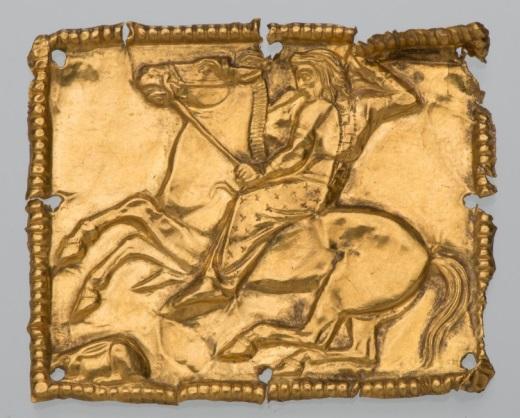

Gold plaque with hare hunt. Kul’ Oba, northern Black Sea region, first half of the 4th century BC. Photo © V. Terebenin 2017.
Dr Simpson then highlighted the significance of the horse – heavily-featured in Scythian gold art – to their society. By successfully domesticating horses, the Scythians revolutionised their society in a way comparable to the Industrial Revolution in Britain. Not only did this transform warfare, but significantly altered the speed of transport. Transport enables trade, and new trade routes, and this new reach likewise creates a transportation of ideas and new technologies, and we see this in Scythian craftsmanship. From this interaction with other cultures we see the inclusion of lions, the apex predator of Persia and a predominant feature of Achaemenid art, in Scythian clothing where we have appliques of lions, and even roaring lions turned into felt work.
Dr Simpson concluded his half of the lecture by noting that history has often approached the Scythians through the lens of others, and then in the 2nd Century CE the Scythians simply disappear. To try and understand what happened, we need to turn to archaeological science, as we can only hear their own voice through their crafts, and their gold-work helps us create a sense of Scythian identity.
Dr Simpson then handed over to Dr Aude Mongiatti, department of conservation and scientific research, who discussed manufacturing technology of the animal-style gold work in the collection. Dr Mongiatti, who works on non-ferrous metal artefacts and ancient metallurgical technologies at the British Museum, specialises in material such as crucible remains associated with metal production. Her research team focused on three non-invasive techniques to examine select items of the Scythian collection:
- Optical Digital Microscopy
- Scanning Electrons Microscopy (SEM) to get accurate images of the 3D objects
- X-Radiography, at high levels of 450 Kr to get through the gold and the bronze
These methods are used to identify the composition of metals and alloys, and to identify the techniques used to produce objects, and were applied to 15 objects from the Hermitage collection, and 8 objects from the Oxus Treasure, consisting of gold belt-plaques made by casting and some by hand.
Read more: As Transparent as a Diamond? Why blockchain technology is making headlines
Dr Mongiatti highlighted the casting surface texture of these items, revealing Scythian manufacturing techniques and processes (which included repoussé, chasing and punching) and also the intricate stone and glass inlays which featured the reuse of gemstones. There was a consistent theme of animal motifs in these objects, and an interesting discovery via the microscopy which revealed dot-impressions used to outline the designs. Yet there was also nothing standard or consistent when it came to attachments, but rather the collection displayed a variety of approaches.
Through digital and radiographic examination, Dr Mongiatti also found unusual textile impressions on the back of some cast belts, and currently we do not know why this occurred. She welcomed any ideas on this, and my own guesses include the possibility that textiles were used in the casting process – or that the textiles had a role in transferring designs – or human error.
Dr Mongiatti then showed us examples of hand-worked sheet metal – which had a strong shine, and demonstrated a more Western Greek/Persian influence compared to the cast-examples. Scientific testing also revealed that some of these objects were hollow, as demonstrated in the X-radiography testing on this Fluted Bowl of 5th-4th century BCE with hammered rivets, which clearly shows that the feline handles are actually hollow and made of two halves which are then attached to the bowl.
This fascinating lecture concluded with a brief Q&A and a drinks reception. I would like to thank the Society for inviting me as a guest to attend this lecture.
The oldest society in the world dedicated to their subject, the Society of Jewellery Historians runs an annual programme of lectures throughout the year, from September to June, with a list of national and international speakers. For future lectures visit: www.societyofjewelleryhistorians.ac.uk/current_lectures
Cover Image: Gold plaque of a mounted Scythian. Black Sea region, c. 400–350 BC. Photo: © V. Terebenin 2017
Interested in finding out more about gemmology? Sign-up to one of Gem-A’s courses or workshops.
If you would like to subscribe to Gems&Jewellery and The Journal of Gemmology please visit Membership.
Dr Sarah Bremner is the editorial coordinator at Gem-A and has a PhD in Classics, Ancient History and Archaeology, specialising in Classical Greece and Athenian Democracy.
{module Blog Articles Widget}

